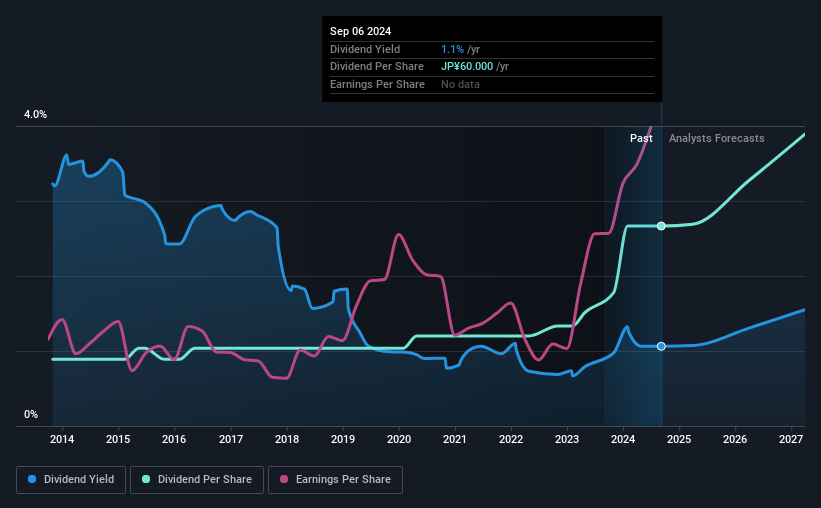
Daiichi Sankyo Company, Limited's (TSE:4568) investors are due to receive a payment of ¥30.00 per share on 9th of December. Despite this raise, the dividend yield of 1.1% is only a modest boost to shareholder returns.
Check out our latest analysis for Daiichi Sankyo Company
Daiichi Sankyo Company's Future Dividend Projections Appear Well Covered By Earnings
The dividend yield is a little bit low, but sustainability of the payments is also an important part of evaluating an income stock. The last dividend was quite easily covered by Daiichi Sankyo Company's earnings. This indicates that quite a large proportion of earnings is being invested back into the business.
Over the next year, EPS is forecast to expand by 20.4%. Assuming the dividend continues along recent trends, we think the payout ratio could be 44% by next year, which is in a pretty sustainable range.

Dividend Volatility
Although the company has a long dividend history, it has been cut at least once in the last 10 years. Since 2014, the annual payment back then was ¥20.00, compared to the most recent full-year payment of ¥60.00. This works out to be a compound annual growth rate (CAGR) of approximately 12% a year over that time. Dividends have grown rapidly over this time, but with cuts in the past we are not certain that this stock will be a reliable source of income in the future.
The Dividend Looks Likely To Grow
With a relatively unstable dividend, it's even more important to evaluate if earnings per share is growing, which could point to a growing dividend in the future. We are encouraged to see that Daiichi Sankyo Company has grown earnings per share at 16% per year over the past five years. Since earnings per share is growing at an acceptable rate, and the payout policy is balanced, we think the company is positioning itself well to grow earnings and dividends in the future.
We Really Like Daiichi Sankyo Company's Dividend
Overall, a dividend increase is always good, and we think that Daiichi Sankyo Company is a strong income stock thanks to its track record and growing earnings. Distributions are quite easily covered by earnings, which are also being converted to cash flows. Taking this all into consideration, this looks like it could be a good dividend opportunity.
Market movements attest to how highly valued a consistent dividend policy is compared to one which is more unpredictable. At the same time, there are other factors our readers should be conscious of before pouring capital into a stock. Companies that are growing earnings tend to be the best dividend stocks over the long term. See what the 15 analysts we track are forecasting for Daiichi Sankyo Company for free with public analyst estimates for the company. Is Daiichi Sankyo Company not quite the opportunity you were looking for? Why not check out our selection of top dividend stocks.
New: Manage All Your Stock Portfolios in One Place
We've created the ultimate portfolio companion for stock investors, and it's free.
• Connect an unlimited number of Portfolios and see your total in one currency
• Be alerted to new Warning Signs or Risks via email or mobile
• Track the Fair Value of your stocks
Have feedback on this article? Concerned about the content? Get in touch with us directly. Alternatively, email editorial-team (at) simplywallst.com.
This article by Simply Wall St is general in nature. We provide commentary based on historical data and analyst forecasts only using an unbiased methodology and our articles are not intended to be financial advice. It does not constitute a recommendation to buy or sell any stock, and does not take account of your objectives, or your financial situation. We aim to bring you long-term focused analysis driven by fundamental data. Note that our analysis may not factor in the latest price-sensitive company announcements or qualitative material. Simply Wall St has no position in any stocks mentioned.
About TSE:4568
Daiichi Sankyo Company
Manufactures and sells pharmaceutical products in Japan, North America, Europe, and internationally.
Flawless balance sheet with solid track record.
Similar Companies
Market Insights
Community Narratives


